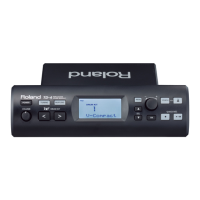43
Other Settings
Deutsch Français Italiano Español Português NederlandsEnglish
LOG1, LOG2
Compared to LINEAR, a soft playing produces a greater change.
fig.VeloC-LOG.eps
SPLINE
Extreme changes are made in response to playing dynamics.
fig.VeloC-SPLINE.eps
LOUD1, LOUD2
Very little dynamic response, making it easy to maintain strong vol-
ume levels. If using drum triggers, these settings help maintain sta-
ble levels.
fig.VeloC-LOUD.eps
Display/Parameter Parameter/Value Explanation
Scan Time
0.4–4.0 (ms)
Specifies the detection time for the trigger signal. Since the rise time
of the trigger signal waveform may differ slightly depending on the
characteristics of each pad or acoustic drum trigger (drum pickup),
you may notice that identical hits (velocity) may produce sound at
different volumes. If this occurs, you can adjust the “Scan Time” so
that your way of playing can be detected more precisely.
fig.ScanTime.eps
While repeatedly hitting the pad at a constant force, gradually raise the Scan Time value from 0.4 msec,
until the resulting volume stabilizes at the loudest level. At this setting, try both soft and loud strikes, and
make sure that the volume changes appropriately.
* As the value is set higher, the time it takes for the sound to be played increases. Set this to the lowest
value possible.
Retrig Cancel
1–16
This setting prevents spurious re-triggering. Important if you are us-
ing acoustic drum triggers. Such triggers can produce altered wave-
forms, which may also cause inadvertent sounding at Point A in the
figure (Re-trigger). This occurs in particular at the decaying edge of
the waveform. Retrig Cancel detects such distortion in and prevents
re-triggering from occurring.
fig.Retrigger.eps
While repeatedly striking the pad, raise the “Retrig Cancel” value until re-triggering no longer occurs.
* Although setting this to a high value prevents retriggering, it then becomes easy for sounds to be
omitted when the drums played fast (roll etc.). Set this to the lowest value possible while still
ensuring that there is no retriggering.
You can also eliminate this problem of re-triggering with the Mask Time setting. Mask Time does not
detect trigger signals if they occur within the specified amount of time after the previous trigger
signal was received. Re-trigger Cancel detects the attenuation of the trigger signal level, and
triggers the sound after internally determining which trigger signals were actually generated when
the head was struck, while weeding out the other false trigger signals that need not trigger a sound.
Display/Parameter Parameter/Value Explanation
LOG2LOG1
Volume
Striking
Force
Volume
SPLINE
Volume
Striking
Force
LOUD2LOUD1
VolumeVolume
Striking
Force
Time
Scan Time
Time
A
TD-4_e.book 43 ページ 2008年11月5日 水曜日 午後6時40分

